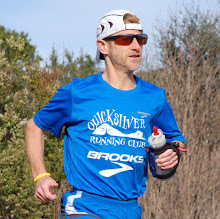I was going to use a more catchy title like "Running injuries: the good, the bad and the ugly" or "Why are running injuries such a pain" because it's so much easier to think about them in a negative way. Let me try the other side of the half glass, which isn't so natural for me...
Why talking about injuries in the first place? Well, because I've been grounded by one for a while now... I didn't share that in the post I wrote in September but, after
my 200 kilometers at the North Coast 24-hour Nationals, I took 2 days off running and resumed training with a slow 10K the following Wednesday. I could feel some pain under the ball of my right foot but still went for 15 more kilometers on Thursday. That Friday, I stopped after 10K again: the pain was bearable but still sharp enough to think that it wasn't soreness anymore but a real foot issue. Walking was very uncomfortable on Saturday and Sunday and I was very happy to get x-rays taken on Monday and a referral to see a podiatrist on Tuesday, himself an active athlete (running and triathlon!). While his prognosis is a fracture of one of the two sesamoid bones in the right foot, the x-ray wasn't conclusive enough and an MRI was needed to say for sure. In the meantime the recommendation was to stop running...
I must say that, with 43,500 miles in my running log, I've been very lucky with injuries, or lack thereof, so far... In 18 years, I had 3 major episodes:
- a. First, while it happened as I was running hard, I wouldn't call last March's TIA stroke a running injury. It was more an accident, and likely rather caused by stress and fatigue.
- b. I had a major injury at the end of another training run when I tripped, fell and broke my shoulder 4 years ago after covering 40 miles of the Tahoe Rim Trail. I had never realized how the upper body was so engaged when running. Indeed, while I had always thought running injuries occurred in the lower body, that one prevented me from running for 6 weeks.
- c. Then there has been the exercise induced asthma occurrences but that's more a condition than an injury. And I managed to keep it under control for the past 5 years by taking Singulair.
Back to the title, I surprised myself by coming up with more than 1 reason injuries are good and beneficial to us! So I pushed the exercise to list a few, but please leave a comment if you can think of others; let's admit it, injuries suck because they prevent us for doing one thing we love, running. Yet, injuries allows us to...
1. Discover and know our body, learn about our amazing and complex anatomy. Every time there is something wrong, I'm in awe by the sophistication of our body. With my shoulder fracture I realized how complex a joint it was, I learned that our skeleton was regenerating itself entirely several times during our lifetime, I discovered how much flexibility our muscles can lose when unused for a few weeks. This time, I learned that we have even more bones in our feet than I thought, with two little sesamoids under the ball of our feet to gain stability. That sesamoid bones were not attached to the skeleton, that the patella was the largest sesamoid and that we could have up to 42 sesamoids in our body (here is
a very good article from MRI Web Clinic). As a matter of fact, I also discovered that not all of us even have these four sesamoids under our feet, and that some may form, or not, at puberty. So intriguing, isn't it? Well, great news that these little bones help our balance except that, given their location, these particular sesamoids in the foot are extremely solicited when running a 24-hour race in particular, each receiving something like 100,000 shocks in a day; of course, being bones, they may break, and being under the foot, they are very long to heal when/if broken because of the lack of blood flow in this area. Yikes...
2. Listen to our body. Better knowing our own body allows us to better listen to it, and follow that famous and wise adage. There is so much noise from all parts of our body when we push the envelope in ultra running, thousands of insights which clash in our mind and even conflict with our willpower or stamina. Unfortunately, in this occurrence, I don't recall a single sign during the race and I'm not sure we can really listen all the time to every bone, or ligament, or muscle all the time either.
3. Uncover and understand our own limits and respect them. I so wish we were indestructible, that the only limits would be breathing, heart rate, leg speed and mental strength but it is obviously not the case as we are reminded all the time on social media. Truth is, we each have our own limits and it's almost an art to push the envelope but remains just on the safe side. Not in the artistic and creativity sense, but the needed skill developed through practice and empirical discovery or exploration.
4. Work on our life balance. Not all of us have an issue with running too much but that's a frequent issue in our sport which has no limit in its definition ("anything longer than a marathon..."). Running injuries may be like road warning signs indicating that we may be overdoing it.
5. Be More appreciative of our gifts. I was driving by one of our local churches the other day and there was this inscription: "Count your blessings, not your problems!" A good reminder to enjoy our abilities to run when we are not injured, but also the myriads of other things working when we are set back by only one temporary injury.
6. Put things into perspective, re-evaluate priorities, relativize our situation. You just need to turn on the TV, or connect to the Internet, to see that there is so much life tragedy which billions of people are going through. Non-runners must not be feeling so sorry for our little running injuries...
7. Make time for others and other things. You can call it "injury... time", the time an injury frees up from running and training. Time to spend more... time with others, catch-up on movies, books, or other hobbies. Or work...
8. Teach us how top cope with (some) loss. Injuries vary a lot in their importance or consequences: some may disappear after a few days or weeks, others may have long lasting effects. As I admitted above, I'm lucky and haven't been affected by the latter ones, and I'm not even talking serious sickness or trauma here, yet, I feel it's fair to say that even the smaller injuries are difficult to accept. In that sense, they teach us or train us to follow the classic steps describes in the figure below (
CycleOfAcceptance): some denial, anger, depression and bargaining, before acceptance. In this sense, minor injuries are a way to experience this cycle in a less traumatic setup.

9. Prepare for a potential end. That's probably the hardest thing which an injury can do to us, make us realize that there may come a time when we may not be able to run anymore, or at least not with the same intensity, not as far, not as fast. Pun intended with regard to my blog title, not indefinitely farther faster... In March, I had sincerely no idea if I was going to be able to run again, less so to race again. While I was feeling completely fine, physically, the doctors were not so optimistic or sure about it and that was frightening. I was very fortunate that all the tests came back negative but, for these first 4 weeks after the incident, I had to think a lot about what my life would be without running...
10. Come back stronger, healthier. Getting injured is an opportunity to switch to another activity, do some cross-training, or strength training. And get more rest that what we may allow ourselves when preparing for big goals. Work on your core for instance, which is so essential in avoiding injury in the first place!
11. Come back smarter and wiser. Smarter about the intensity in races or variety in training sessions. Wiser with more patience, more reason which, in turn, will make us more resilient. Last but not least, wiser by keeping our ego in check... After all, 99.9% of us aren't making a living of running, it's just a hobby so not worth killing ourselves in the process...
Did I smoke something to be so prolific when looking at good aspects of running injuries and being philosophic about them? I swear not, must just be that I'm aging, if not maturing. ;-) At least, not having run for 5 weeks now gave me some time to think about the matter...
Hope you are doing fine and, if that's the case, you cherish all the injury-free time you are gifted with. Otherwise, if injured from running, that you are able to find some life wisdom while dealing with the setback, then recover and bounce back as quickly as nature and your body allow.
PS: again, please leave a comment if you see other positive aspects of running injuries!











.jpg )
